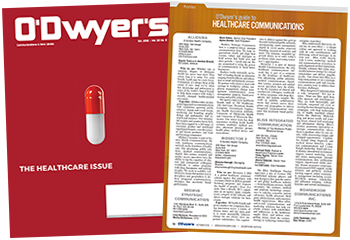 Brian Reid |
Last summer, when the biopharmaceutical industry was still reeling from President Donald Trump’s pivot from on-again, off-again threats to a nascent blueprint regarding how his administration would drive down drug pricing, a grizzled veteran of pharmaceutical communications dropped a critical piece of wisdom.
“There is no such thing as corporate social responsibility programming anymore. The only thing consumers care about from a reputation standpoint is pricing.”
It was the distillation of what’s increasingly conventional wisdom. By most conventional metrics, healthcare companies should be the nation’s most reputable companies. In September, the Chronicle of Philanthropy singled out the biopharmaceutical industry as among the most generous. The collective mission of companies in this space — to treat diseases with innovative medicines that reduce pain and disability and prevent death — could not be more noble.
But drugmakers and biotechnology companies don’t — and won’t — receive full credit for their efforts, or the attendant risks of drug development, as long as the perception exists that the costs of medicines are unsustainable.
Ducking the issue of drug pricing is no longer a viable strategy. Absent a strong defense from innovative companies, the conversation will be steered by those trying to pinpoint blame or, even worse, by trolls purporting to speak for the industry. This summer, a CEO from a fringe maker of generic drugs captured headlines from CNN to the Washington Post to the New Republic by bragging about a 400 percent price hike for an antibiotic.
It didn’t matter that the company wasn’t even making the drug in question at the time, or that competitors exist that would make sure such a stunt was meaningless in practice. The media pounced. However, lost in the frenzy was the critical context: drug prices in 2017 barely budged, according to the companies that manage drug spending for health insurance plans. The data are clear: we’re now living in an era where medicines are reducing the rate of healthcare spending, not driving it up.
So, what can biopharma companies do?
First, they should understand that controversies around pricing are real, and they come from many different directions. Sometimes, it’s patients who are concerned about “financial toxicity,” other times it’s governments that worry about total costs. There’s no single formula for a pricing-related controversy, and drugmakers must be consistently on alert for decisions — including decisions made by others in the healthcare system — that could impact any of their stakeholders.
Second, companies must commit to being transparent. Consumers, policymakers, the media and others have a right to better understand the pricing policies that drugmakers follow, and companies should be able to describe how they bring value to patients and healthcare providers, as well as how they define “value.”
That’s easier said than done: the wholesale price of a medicine is often vastly different from the price that an insurance company pays, which is different from what the pharmacy pays, and often bears little relation to the actual cost that a patient pays at the pharmacy counter. But beginning to tease that system apart is critical to rebuilding trust.
Third, companies must recognize that more education is needed at every level of the healthcare system. The complexity of the system makes for a lot of misplaced anger — anger that too often flows to the most visible part of the system: the biopharmaceutical companies. Yet, a web of factors impacts the price of every drug, most of which is not communicated well.
Doctors and patients should understand the value of the treatments in ways meaningful to them so they can make smart choices. And consumers must be aware of the impact of the way insurance design has an impact on their bottom line so they can ask the right questions of their employer or insurance plan.
Fourth, companies need to make clear what their principles are and stand by them. Over the past two years, a growing number of companies have made public commitments on issues from transparency, to how they set the price of new drugs, to when and by how much they increase prices, to new and better ways of serving uninsured or underinsured patients.
That kind of leadership is a prerequisite for reinvigorating corporate responsibility efforts. It doesn’t necessarily pay off in the short term — the media can be skeptical — but, over time, making good on such commitments builds a foundation of goodwill with key stakeholders.
Building a communications program around understanding, transparency, education and action is not solely a question of reputation, though restoring reputation is a clear goal of such a program. It’s critical, too, that biopharmaceutical companies make clear that the profits — when there are profits — are used to fuel the engine of innovation. Today’s successes make way for tomorrow’s cures, even though there’s no assurance that the pathway to those cures won’t lead to a dead end.
The industry walks a tightrope: a backlash against high healthcare costs erodes reputation, but a pendulum that moves too far in the opposite direction is just as dangerous. Creating new medicines is not easy, fast or cheap. Destroy the ability of companies to earn a reward for that risk and the would-be investors in tomorrow’s breakthroughs will decide that funding yet another scooter-sharing service or a robot-run fast causal restaurant is a better use of their capital.
Many companies have already taken steps to begin to address looming questions about the value of pharmaceuticals, both in terms of specific products as well as the health spending implications across the system.
Externally engaging in the topic is not without risks, but those that have developed a strong stance on the issue — as well as a strong backbone in delivering their defense — have begun to have an impact on the public debate.
Now is the time for more companies to join the dialogue, even if the payoff isn’t immediate. To paraphrase an old saw, the best time to jump into the value conversation was 20 years ago. The second-best time is now.
***
Brian Reid is managing director of healthcare and co-leads the Value and Access Practice at W2O.



 Lo Isidro, senior director at Real Chemistry with more than a decade of strategic communications and PA experience, has joined Narrative Strategies.
Lo Isidro, senior director at Real Chemistry with more than a decade of strategic communications and PA experience, has joined Narrative Strategies. Nelson Fernandez, former North American chair of APCO Worldwide and managing director of Burson-Marsteller, has joined Volunteers in Medicine Berkshires as director of communications and PA.
Nelson Fernandez, former North American chair of APCO Worldwide and managing director of Burson-Marsteller, has joined Volunteers in Medicine Berkshires as director of communications and PA. Lilit Bargar, who was most recently an EVP in the healthcare practice at Weber Shandwick, comes on board at GCI Health as EVP, corporate practice lead.
Lilit Bargar, who was most recently an EVP in the healthcare practice at Weber Shandwick, comes on board at GCI Health as EVP, corporate practice lead.
 Five ways that successful thought leaders are made.
Five ways that successful thought leaders are made.


 Have a comment? Send it to
Have a comment? Send it to 
No comments have been submitted for this story yet.